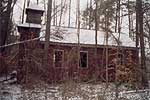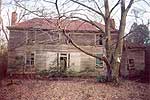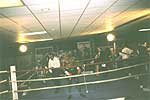Anatomy of a Fight Card. An Inside Look
at a Duva Sponsored Boxing Card.
1- Ruben Flores - New York vs Reid Gossett - North Carolina
2- Martin Musoke - Virginia vs Stacey Burris - Virginia
3- Todd Lemaster - North Carolina vs Marc Randazzo - Chicago,
Illinois
4- Alonzo Cutchins- Norfolk, Virginia vs Cornelius Harris
- Norfolk, Virginia
5 Antonio Carter- Bogalusa, Louisiana vs Pernel Whitaker
- Norfolk, Virginia
There
was a sparse crowd attending the small professional boxing
card, less than 400 people had shown up at the Virginia
Beach Pavilion located near the main street in Virginia Beach,
Virginia. The card was promoted by the Duvas. They were known
in boxing circles as the first family of boxing. They had
a stable of fighters including local favorite Pernel Whitaker.
Whitaker was an Olympic gold medalist. He was fighting in
the main event and was slowly becoming popular. By himself
he drew most of the fans and media. They were there to see
him showcase his skills. With this talents and the backing
of the Duvas he could become a future world champion. Tonight
was a stepping stone in that process. It seemed as though
most fans and media had not attended a boxing match before
and did not know what to expect. They were curious, interested
and hopeful the money they spent on tickets would be worth
it. Most mingled before the bouts began, some bought hot
dogs and cokes. As fight time
approached the fans and ringside media took to their seats
and it was time for the bouts to begin.
The
first bout listed on the program, which was passed out
freely by the Pavilion, was in the cruiserweight division.
It featured Ruben Flores from New York who was making his
pro debut vs Reid Gossett from North Carolina whose record
was listed at 3 wins with 1 loss. The bout was scheduled
for four rounds. Undercard bouts offer young fighters an
opportunity to gain experience and advance their careers.
Tonight Flores as well as Gossett were hopeful they would
win and they had to prove it themselves. For boxing, unlike
most sports is by no means a team sport. When the bell rings
the boxer the boxer goes into the ring totally alone. With
punches being thrown by the adversary whose goal is to
score a knockout, anything can happen in there. Each novice
boxer had to recognize this and be cautious. Neither fighter
wanted to lose or be hurt in the ring.
Gossett was the first to walk to the ring. He had on a towel
torn in the middle and worn over his shoulders instead of
a robe. He had on white shorts and shoes that were not necessarily
of a boxing style and was moderately muscled. Instead of
an entourage he had only one cornerman accompanying him.
When he entered the ring the crowd seem to glare curiously
at him and he drew no applause. Next to walk toward ring
was a robust and heavily muscled Flores. He was accompanied
by Lou Duva, the trainer for all Duva fighters and a handful
of cornermen. His shorts were red and of a boxing style and
he also had a torn towel in the center over his head. Tonight,
with the backing of the Duvas, he was a house fighter which
can be a big advantage in boxing. Flores entered the ring
with the crowd veering to see him. Almost immediately the
two fighters eyed each other and began warming up by throwing
punches in the air. While Ruben Flores looked Puerta Rican,
Gossett was white. The referee signaled both fighters to
the center of the ring for final instructions and the crowd
whistled in anticipation of an exciting bout.
The bell rang and the two fighters began cautiously circling
the ring. Gossett advanced and threw the first punch which
was a left jab and followed by a right. Flores covered up
and the punches landed solely on his gloves and he seemed
unhurt. Gossett advanced again throwing punches and Flores
covered up and was unhurt. Then, in an instant, Flores, heavily
muscled with quick hands, opened up landing a three punch
combination to Gosset's head and face. The punches were loud
and echoed throughout the small arena and drew the attention
of the fans. Reid Gossett was stunned and surprised at the
accuracy and power of the punches. He paused for a moment
and then naively advanced again and when he was in Flores's
range was caught with two big punches and he went straight
to the canvas. The fight was over, Reid never beat the count.
He was conscious but badly dazed and unable to get up. Virginia
State Commission doctors rushed into the ring to see if he
was all right while a victorious Ruben Flores celebrated
in his corner. After several minutes he rose and exited the
ring. As he left ringsiders looked at him and his face was
beginning to redden and swell from the punches he had taken.
Boxing is indeed a brutal sport and fans and media were just
witness to such in a vivid capacity. For someone who never
attended a boxing match before it was a rude awakening and
fans were dumbfounded. It seemed to volatile, too extreme,
this is actually a sanctioned sport.
The
next bout on the Duva Sponsored fight card featured Stacey
Burris versus Martin Mouske, scheduled for four rounds
in the junior welterweight division. Burris had record of
6 wins with 1 loss while Mouske had 3 wins with 1 loss. Both
fighters were black and from Virginia. Unlike the first,
this bout offered fans a much more competitive fight. Each
boxer had some experience and knew the basics of boxing.
When the bell rang Burris used his boxing skills to outbox
Mouske who was repeatedly hit with overhand rights. After
four rounds Burris won a decision and looked relatively sharp
in doing so. Unfortunately he was not a Duva fighter but
with better management and steady improvement he had
some potential. Musoke needed to polish some of his skills,
he was easily hit way too many times. This bout was easier
to watch for the fans and lacked the savagery of the first
bout on the card.
There was a brief intermission after the conclusion of the
second bout. Then it was time for the next bout. It was scheduled
for four rounds in the cruiserweight division. It featured
Todd Lemaster from North Carolina versus Duva prodigy Mark
Randazzo from Chicago, Illinois. Randazzo had 1 win with
0 losses while Lemaster was making his pro-debut. Both fighters
were white. Mark stood around six foot one and was in excellent
shape. He had broad shoulders and a powerful looking physique.
He was a fighter with potential being groomed by the Duvas.
Warming up in his corner he looked like a true professional.
In contrast, Todd Lemaster, who had the same cornerman as
Reid Gossett who was previously stopped in the first round
looked totally out of shape. He lacked a solid physique and
his shoes and shorts were not of a boxing style. One ringsider
put it this when he saw Lemaster, "where did they get
this guy from, he's going to fight." This bout was a
mismatch It could be defined as a palooka versus a prospect.
To the fans Lemster was crazy to even step into the ring
that night. His opponent Randazzo could easily knock him
out in his pro debut. There seemed little likelihood that
this bout would last one round. The bell rang and the bout
started with Randazzo advancing on Lemaster. Randazzo quickly
got Lemaster on the ropes and began unloading powerful overhand
rights on him. Lemaster game fully covered up but was not
strong enough to stop the heavy punching. Within thirty seconds
he absorbed too many punches and was on the canvas. He rose
quickly and the referee gave him a ten count and the bout
continued. He took several more punches and unable to defend
himself was on the canvas again. The fight was over. He did
not get up for several minutes as Virginia State Commission
doctors rushed into the ring to see if he was ok. He moved
a little and after five minutes got up and walked to his
corner and exited the ring. He seemed to almost sneak back
to his dressing room while a victorious Mark Randazzo celebrated
in his corner.
Neither
fighter from North Carolina had lasted more than minute
in his bout and lost badly. North Carolina is a state
with virtually no boxing commission. It is known for producing
opponents, fighters who go from town to town losing to local
favorites to help them build their records. Anyone watching
Todd Lemaster or Reid Gossett in the ring would have to question
their credentials. Were they qualified to fight professionally?
Did they have amateur experience? Were they really who they
said they were or perhaps fighting under an alias; a relatively
common practice in the shadowy world of professional boxing.
One thing for sure, neither fighter took a dive tonight and
just collected their checks. Each
fought back and were legitimately knocked out, such was clearly
visible to all ringside observers.
The
next bout involved Cornelius Harris versus Alonzo Cutchins
also in the cruiserweight division. Cornelius Harris was
from Norfolk, Virginia, with a record of 1 wins and 1 loss.
Cutchins was from Charlottesville, Virginia, and had a record
of 6 wins and 4 losses. The bout was scheduled for four rounds
and both fighters were black. Harris stood six feet tall
and looked like the perfect all around athlete. He was well
proportioned, heavily muscled and looked to be in great shape.
Cutchins meanwhile stood around six foot four and looked
lanky. He was not heavily muscled but did have ten fights
under his belt, six of which he had won. To most ringsiders
it looked as though Cutchins would not posses the
strength to stop an assault form Harris. Most expected a
quick knockout of Cutchins by Harris. The referee gave the
fighters their instructions and the bell rang to begin the
bout. Harris advanced quickly and used a sharp jab to keep
Alonzo off balance. When he got in close he threw overhand
rights which Cutchins could not avoid. After two rounds Harris
was dominating the fight and ahead on the scorecards. Round
three was the same with Harris throwing and Cutchins just
absorbing punches and unable to stop the aggressive attack
of Harris. Cutchins extensive experience and overall ring
savvy kept him from being knocked out or from the referee
stopping the bout. The fourth and final round began and was
almost a repeat of the earlier rounds. But boxing can be
the theater of the unexpected and one can never know what
to expect. Midway through the final round, out of nowhere,
Cutchins landed a big overhand right on a stunned Harris.
Harris went straight to the canvas and never got up. It was
a knockout punch and Cutchins despite being way behind on
points rose to the occasion. He had no quit in him. Knockout
victory for Cutchins and the crowd applauded as the two game
warriors exited the ring. Great four round fight.
The
next fight on the card was in the middleweight division.
It was scheduled for four rounds. It featured John Keys who
had a record of 8 wins, 6 losses with 1 draw against Ken
Shannon who had a record of 20 wins 4 losses. Shannon at
one time had a national ranking. His opponent John Keys was
built like a body builder and in terrific condition. Shannon
was short and stocky. Looking at their
records it looked like it would be an easy night for Shannon.
On paper he was more experienced and had better credentials.
After a brief stare down and the referee's instructions the
bout began. Shannon started fast and just kept coming at
Keys. Keys simply covered up and retreated when necessary.
Throughout the fight, Keys initiated a limited offense and
just took all the punches. However, he never Was on the canvas
and never seemed to be in any serious trouble. He maintained
a small spurt of punches per round but outside of that he
just covered up. Finally after seven rounds of such he did
something bizarre. He landed a succession of punches that
rocked Shannon. He kept punching and then knocked him down
and the action continued with Shannon out on his feet. The
referee then stopped the fight. It was an exciting contest.
Hopelessly behind on points Keys scored a big come from behind
knockout. As he left the ring fans and media congratulated
him on his tremendous victory.
So far the fight
card had consisted of three knockouts and one decision.
It was an exciting night so far and now it
was time for the main event. It featured Pernel "sweet
pea" Whitaker from Norfolk, Virginia versus Antonio
Carter from Bogalusa, Louisiana. It was scheduled for ten
rounds. Whitaker had a record of 15 wins with 1 loss while
Carter was 9 wins with 6 losses When Whitaker entered the
ring the crowd cheered their local favorite loudly. He bowed
in acknowledgement. After the instructions by the referee
the bout began. Whitaker, a technician, boxed and never allowed
a game but outclassed
Carter to get inside and land. Whitaker used the ring and
his style to win the rounds. As the second round came to
an end, Whitaker began landing overhand rights that were
rocking Carter. During the third round Whitaker dazzled the
crowd and media as he put on a boxing clinic. He stalked
his opponent and landed all types of punches simultaneously
not allowing his opponent to land at all. With fast reflexes
he had the ability to hit and not be hit. His boxing skills
were incredible. So far had won every round. In round four
he knocked Carter down and Carter rose. The Virginia State
Commission director Al Rothenberg signaled to the referee
that the fight needed to be stopped. Carter could no longer
fight on. Whitaker had won and looked like a true champion.
With boxing ability like that a title shot was down the line
for him. Carter, game, but outclassed had lost via knockout.
Whitaker mingled for a short while with some of the ringside
fans and media. He did a brief interview then made his was
to the locker room.
That was the end of the bouts. There were five bouts total
and four ended by knockout. Overall it was a good card and
the fighters delivered good quality action. The Duvas also
did a good job promoting. I was curious as to what ever happened
to the fighters on the card careerwise. Ruben Flores had
only four more bouts, the last two of which he lost via knockout,
he then retired. Todd Lemaster never fought again and Reid
Gossett had six more fights losing all before quitting the
ring. Lemaster or Gossett were never from North Carolina
but really from Spartanburg, South Carolina. Pernel Whitaker
and Marc Randazzo both advanced in the pro ranks and captured
world titles. Whitaker, was at one time pound for pound one
of the best in the world and upon completion of his career
was considered to be a great fighter. What happened to the
other fighters careerwise is unknown. It cost twenty dollars
to sit Ringside that night and attend the fights. Was it
worth it? Definitely so and any fan in attendance would Agree.
top




















